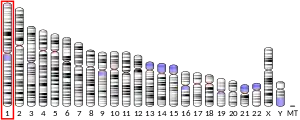Zinc finger CCCH domain-containing protein 11A is a protein that in humans is encoded by the ZC3H11A gene.[4][5] ZC3H11A is a part of the transcription export (TREX) complex and plays a role in exporting of mRNAs from nucleus to cytoplasm.[6] It is considered as stress-induced nuclear protein and maintains mRNAs exporting when the cells are under stress.[7] Loss of functioning of ZC3H11A gene in HeLa cells results in abortion of the replication of nuclear replicating viruses but not cytoplasmic replicating viruses.[8] It is discovered that ZC3H11A is significant for viability and metabolic regulation of mouse embryo[9]
References
- 1 2 3 GRCh38: Ensembl release 89: ENSG00000058673 - Ensembl, May 2017
- ↑ "Human PubMed Reference:". National Center for Biotechnology Information, U.S. National Library of Medicine.
- ↑ "Mouse PubMed Reference:". National Center for Biotechnology Information, U.S. National Library of Medicine.
- ↑ Ishikawa K, Nagase T, Suyama M, Miyajima N, Tanaka A, Kotani H, et al. (June 1998). "Prediction of the coding sequences of unidentified human genes. X. The complete sequences of 100 new cDNA clones from brain which can code for large proteins in vitro". DNA Research. 5 (3): 169–176. doi:10.1093/dnares/5.3.169. PMID 9734811.
- ↑ "Entrez Gene: ZC3H11A zinc finger CCCH-type containing 11A".
- ↑ Folco EG, Lee CS, Dufu K, Yamazaki T, Reed R (23 August 2012). "The proteins PDIP3 and ZC11A associate with the human TREX complex in an ATP-dependent manner and function in mRNA export". PLOS ONE. 7 (8): e43804. doi:10.1371/journal.pone.0043804. PMC 3426524. PMID 22928037.
- ↑ Younis S, Kamel W, Falkeborn T, Wang H, Yu D, Daniels R, et al. (April 2018). "Multiple nuclear-replicating viruses require the stress-induced protein ZC3H11A for efficient growth". Proceedings of the National Academy of Sciences of the United States of America. 115 (16): E3808–E3816. doi:10.1073/pnas.1722333115. PMC 5910864. PMID 29610341.
- ↑ Younis S, Kamel W, Falkeborn T, Wang H, Yu D, Daniels R, et al. (April 2018). "Multiple nuclear-replicating viruses require the stress-induced protein ZC3H11A for efficient growth". Proceedings of the National Academy of Sciences of the United States of America. 115 (16): E3808–E3816. doi:10.1073/pnas.1722333115. PMC 5910864. PMID 29610341.
- ↑ Younis S, Jouneau A, Larsson M, Oudin JF, Adenot P, Omar J, et al. (June 2023). "Ablation of ZC3H11A causes early embryonic lethality and dysregulation of metabolic processes". Proceedings of the National Academy of Sciences of the United States of America. 120 (23): e2216799120. doi:10.1073/pnas.2216799120. PMC 10266022. PMID 37252988.
Further reading
- Venter JC, Adams MD, Myers EW, Li PW, Mural RJ, Sutton GG, et al. (February 2001). "The sequence of the human genome". Science. 291 (5507): 1304–1351. doi:10.1126/science.1058040. PMID 11181995.
- Ota T, Suzuki Y, Nishikawa T, Otsuki T, Sugiyama T, Irie R, et al. (January 2004). "Complete sequencing and characterization of 21,243 full-length human cDNAs". Nature Genetics. 36 (1): 40–45. doi:10.1038/ng1285. PMID 14702039.
- Beausoleil SA, Jedrychowski M, Schwartz D, Elias JE, Villén J, Li J, et al. (August 2004). "Large-scale characterization of HeLa cell nuclear phosphoproteins". Proceedings of the National Academy of Sciences of the United States of America. 101 (33): 12130–12135. Bibcode:2004PNAS..10112130B. doi:10.1073/pnas.0404720101. PMC 514446. PMID 15302935.
- Kimura K, Wakamatsu A, Suzuki Y, Ota T, Nishikawa T, Yamashita R, et al. (January 2006). "Diversification of transcriptional modulation: large-scale identification and characterization of putative alternative promoters of human genes". Genome Research. 16 (1): 55–65. doi:10.1101/gr.4039406. PMC 1356129. PMID 16344560.
- Nousiainen M, Silljé HH, Sauer G, Nigg EA, Körner R (April 2006). "Phosphoproteome analysis of the human mitotic spindle". Proceedings of the National Academy of Sciences of the United States of America. 103 (14): 5391–5396. doi:10.1073/pnas.0507066103. PMC 1459365. PMID 16565220.
- Beausoleil SA, Villén J, Gerber SA, Rush J, Gygi SP (October 2006). "A probability-based approach for high-throughput protein phosphorylation analysis and site localization". Nature Biotechnology. 24 (10): 1285–1292. doi:10.1038/nbt1240. PMID 16964243. S2CID 14294292.
- Olsen JV, Blagoev B, Gnad F, Macek B, Kumar C, Mortensen P, Mann M (November 2006). "Global, in vivo, and site-specific phosphorylation dynamics in signaling networks". Cell. 127 (3): 635–648. doi:10.1016/j.cell.2006.09.026. PMID 17081983. S2CID 7827573.
This article is issued from Wikipedia. The text is licensed under Creative Commons - Attribution - Sharealike. Additional terms may apply for the media files.

